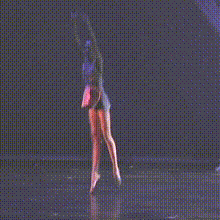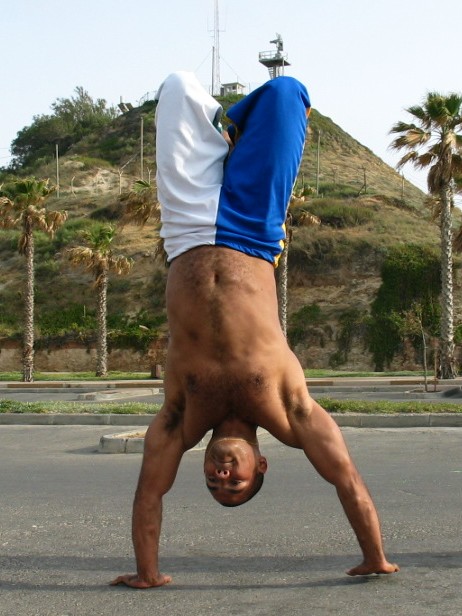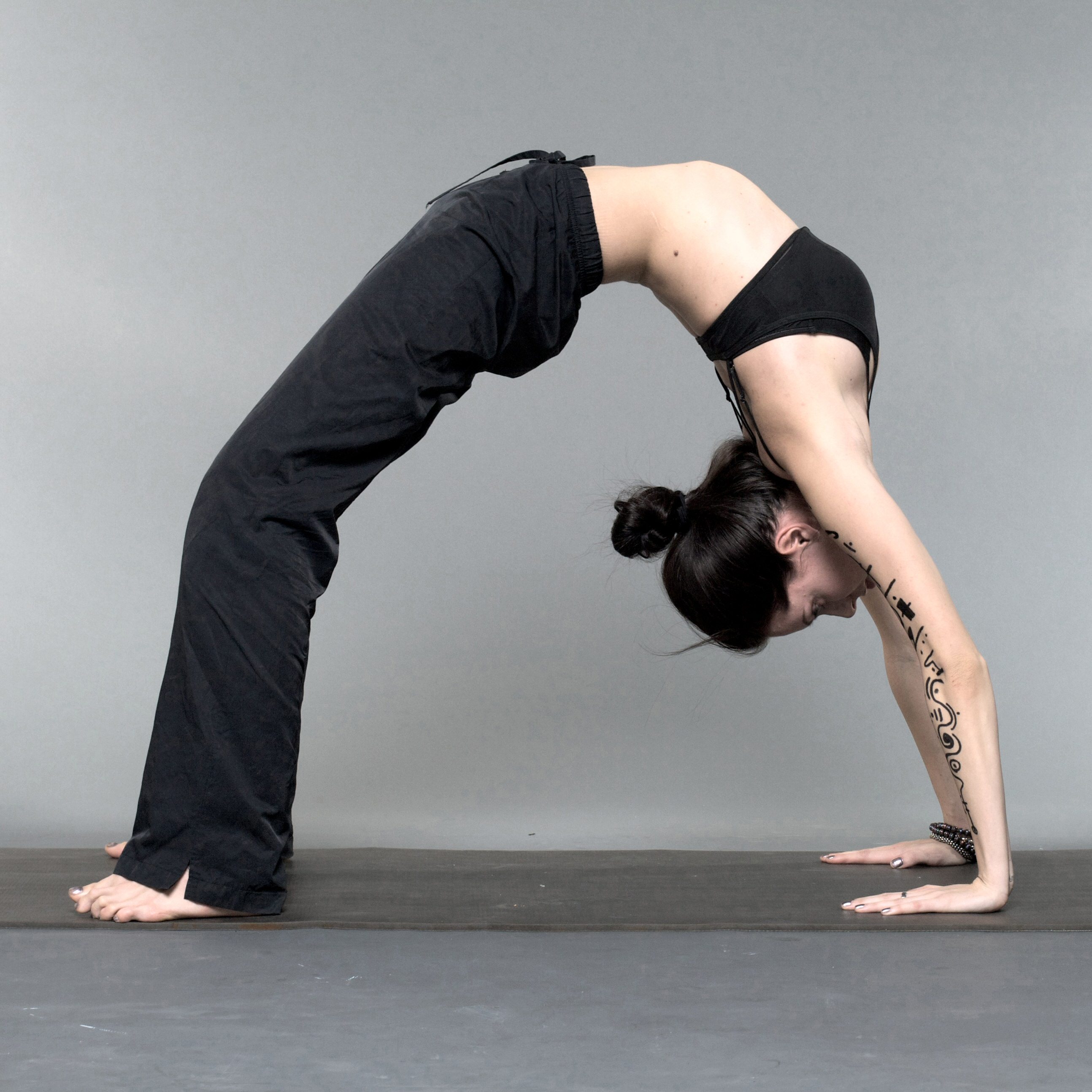|
Front Walkover
A front walkover is an acrobatic movement sequence. It begins with the performer standing up straight with arms raised and positioned near to the ears. The performer then lunges forward and quickly raises one leg, with the other leg following as if transitioning to a handstand. The legs are held straight in a split as they travel overhead. The back is then arched until the leading foot touches the floor, such that the performer is briefly in a back bridge position. After the trailing foot reaches the floor, the performer returns to a standing position. In gymnastics, a front walkover typically ends with one foot extended in front and arms raised. Front walkovers are performed in various activities, including acro dance, circus, and gymnastics. See also *Back walkover *Front aerial *Front limber A front limber is a gymnastics skill where the gymnast performs a handstand, carries the momentum forward, landing in a bridge, and then pulls their upper body upwards, ending in a standing ... [...More Info...] [...Related Items...] OR: [Wikipedia] [Google] [Baidu] |
Acrobatic
Acrobatics () is the performance of human feats of balance (ability), balance, agility, and motor coordination. Acrobatic skills are used in performing arts, sports, sporting events, and martial arts. Extensive use of acrobatic skills are most often performed in acro dance, circus, and gymnastics, and to a lesser extent in other athletic activities including ballet, slacklining and Diving (sport), diving. Although acrobatics is most commonly associated with human body performance, the term is used to describe other types of performance, such as aerobatics. History Acrobatic traditions are found in many cultures, and there is evidence that the earliest such traditions occurred thousands of years ago. For example, Minoan civilization, Minoan art from c. 2000 BC contains depictions of bull-leaping, acrobatic feats on the backs of bulls. Ancient Greeks practiced acrobatics, and the noble court displays of the European Middle Ages would often include acrobatic performances that ... [...More Info...] [...Related Items...] OR: [Wikipedia] [Google] [Baidu] |
Handstand
__NOTOC__ A handstand is the act of supporting the body in a stable, inverted vertical position by balancing on the hands. In a basic handstand, the body is held straight with arms and legs fully extended, with hands spaced approximately shoulder-width apart and the legs together. There are many variations of handstands, all of which require the performer to possess adequate balance and upper body strength. Kinematics Handstands use the wrist flexor muscles as well as the anterior deltoid, pectoralis major, latissimus dorsi, biceps brachii, and trapezius descendens. It is considered demanding in terms of both the muscle and joint requirement. According to a 2017 study most handbalancers use wrist movement to maintain balance in a handstand. Another study found that handbalancers who were also expert gymnasts had better coordination than those at an intermediate level of gymnastics. More advanced practitioners also altered their center of pressure less to change the center of mas ... [...More Info...] [...Related Items...] OR: [Wikipedia] [Google] [Baidu] |
Back Bridge
Chakrasana ( sa, चक्रासन, lit=Wheel Pose, translit=Cakrāsana) or Urdhva Dhanurasana ( sa, ऊर्ध्वधनुरासन, lit=Upward-Facing Bow Pose, translit=Ūrdhvadhanurāsana) is a backbending asana in yoga as exercise. The one-legged variant is often chosen by yoga practitioners who wish to advertise themselves. Etymology and origins The name Chakrasana comes from the Sanskrit words चक्र ''chakra'', "wheel", and आसन ''āsana'', "posture" or "seat". The name Urdhva Dhanurasana comes from the Sanskrit ''urdhva'' ऊर्ध्व, upwards, and ''dhanura'' धनु, a bow (for shooting arrows). The pose is illustrated in the 19th century ''Sritattvanidhi'' as ''Paryaṇkāsana'', Couch Pose. Description In the general form of the asana, the practitioner has hands and feet on the floor, and the abdomen arches up toward the sky. It may be entered from a supine position or through a less rigorous supine backbend, such as Setu Bandha Sarva ... [...More Info...] [...Related Items...] OR: [Wikipedia] [Google] [Baidu] |
Gymnastics
Gymnastics is a type of sport that includes physical exercises requiring balance, strength, flexibility, agility, coordination, dedication and endurance. The movements involved in gymnastics contribute to the development of the arms, legs, shoulders, back, chest, and abdominal muscle groups. Gymnastics evolved from exercises used by the ancient Greeks that included skills for mounting and dismounting a horse, and from circus performance skills. The most common form of competitive gymnastics is artistic gymnastics (AG), which consists of, for women (WAG), the events floor, vault, uneven bars, and beam; and for men (MAG), the events floor, vault, rings, pommel horse, parallel bars, and horizontal bar. The governing body for gymnastics throughout the world is the Fédération Internationale de Gymnastique (FIG). Eight sports are governed by the FIG, which include gymnastics for all, men's and women's artistic gymnastics, rhythmic gymnastics, trampolining (including double mini-t ... [...More Info...] [...Related Items...] OR: [Wikipedia] [Google] [Baidu] |
Acro Dance
Acro dance is a style of dance that combines classical dance technique with precision acrobatic elements. It is defined by its athletic character, its unique choreography, which seamlessly blends dance and acrobatics, and its use of acrobatics in a dance context. It is a popular dance style in amateur competitive dance as well as in professional dance theater and in contemporary circus productions such as those by Cirque du Soleil. This is in contrast to acrobatic, artistic and rhythmic gymnastics, which are sports that employ dance elements in a gymnastics context under the auspices of a governing gymnastics organization (such as FIG) and subject to a Code of Points. Acro dance is known by various other names including ''acrobatic dance'' and ''gymnastic dance'', though it is most commonly referred to simply as ''acro'' by dancers and dance professionals. Acro is an especially challenging dance style for dancers as it requires them to be trained in both dance and acrobatic sk ... [...More Info...] [...Related Items...] OR: [Wikipedia] [Google] [Baidu] |
Back Walkover
A back walkover is an acrobatic maneuver in which a person transitions from a standing position to a back bridge and then back to a standing position again, undergoing a complete revolution of the body in the process. Back walkovers are commonly performed in a variety of athletic activities, including acro dance, cheerleading, and rhythmic gymnastics. In artistic gymnastics, back walkovers are performed in floor exercises and on the balance beam. Technique The back walkover performer begins in a standing position. The back is increasingly arched and abdominal muscles are stretched until the hands touch the floor and all hands and feet are flat on the floor, thus forming a gymnastic back bridge. While in the bridge position, one leg (the ''leading'' leg) is rapidly raised from the floor so as to impart momentum to the lower body. This momentum lifts the trailing leg from the floor so that only the hands are left touching the floor. Both hands remain on the floor while the body revolv ... [...More Info...] [...Related Items...] OR: [Wikipedia] [Google] [Baidu] |
Front Aerial
A front aerial is an acrobatic move in which a person executes a complete forward revolution of the body without touching the floor. Front aerials are performed in various physical activities, including acro dance and gymnastics. The front aerial is known by other names, including ''aerial walkover'', ''front aerial walkover'', ''front flip'' and ''front somersault''. Technical The front aerial differs from a front tuck in that the body assumes a form similar to that of a front walkover, with legs extended and split along the plane of rotation, whereas in a front tuck the knees are bent and held against the chest (i.e., "tucked") so as to maximize rotational velocity. To compensate for lack of support from the floor, as well as the decreased rotational velocity that results from extended (versus "tucked") legs, a front aerial performer uses the inertia of the legs to keep the body aloft until the move is completed. A front aerial can be executed either from a run or from a stati ... [...More Info...] [...Related Items...] OR: [Wikipedia] [Google] [Baidu] |
Front Limber
A front limber is a gymnastics skill where the gymnast performs a handstand, carries the momentum forward, landing in a bridge, and then pulls their upper body upwards, ending in a standing position. It is related to a front walkover, but it is a variant as both legs are carried forward at once whereas each leg is taken over separately in a walkover. This is how it is done correctly: #Kick up into handstand, and hold it momentarily. #Push shoulders 'out' and arch the back, with feet together and toes pointed. #Bend knees until feet land on the floor. #Immediately push the hips forward and push off the hands to stand up ending with arms overhead. Tips: Look at hands throughout #Land with feet about a foot apart #Stretch back before doing a front limber #If doing for the first time, do on to a raised surface (sofa, mat) as the back does not have to arch as much. Similar gymnastic skills *Back limber *Front walkover, Back walkover A back walkover is an acrobatic maneuver in whic ... [...More Info...] [...Related Items...] OR: [Wikipedia] [Google] [Baidu] |
Gymnastics Elements
Gymnastics is a type of sport that includes physical exercises requiring balance, strength, flexibility, agility, coordination, dedication and endurance. The movements involved in gymnastics contribute to the development of the arms, legs, shoulders, back, chest, and abdominal muscle groups. Gymnastics evolved from exercises used by the ancient Greeks that included skills for mounting and dismounting a horse, and from circus performance skills. The most common form of competitive gymnastics is artistic gymnastics (AG), which consists of, for women (WAG), the events floor, vault, uneven bars, and beam; and for men (MAG), the events floor, vault, rings, pommel horse, parallel bars, and horizontal bar. The governing body for gymnastics throughout the world is the Fédération Internationale de Gymnastique (FIG). Eight sports are governed by the FIG, which include gymnastics for all, men's and women's artistic gymnastics, rhythmic gymnastics, trampolining (including double mini-t ... [...More Info...] [...Related Items...] OR: [Wikipedia] [Google] [Baidu] |




